The spectacular diversity of nanoporous crystals
Scientists from the Vrije Universiteit Brussel and the Universität Leipzig have discovered a unique behavior in the transport of molecules in nanoporous materials. They disproved the validity of a decades-old unquestioned assumption and demonstrated that each individual nanoporous crystal behaves differently. This finding may radically alter future research in the field, as current conventional techniques are based on this invalid assumption.
Nanoporous materials, like zeolites or metal-organic frameworks, contain pores with a size of less than one millionth of a (milli-)meter, in which molecules can be stored or converted into other molecules. They are of great importance for our society, finding widespread applications, for example as environment-friendly catalysts to accelerate the chemical conversion of molecules into useful products, (and) as molecular sponges in the purification of gases and liquids, for CO2 capture or even in medical applications.
The development and improvement of such practical applications crucially depends on the understanding of the mechanisms of molecular transport within the nanopores. The rate of chemical reactions in these nanopores is largely controlled by the transport rate. Since nanoporous crystals are constructed from identical building blocks, researchers have always believed that the mechanism and rate of molecular transport is identical for different crystals of the same family.
In their research towards the sustainable recovery and purification of bio-alcohols as an alternative for chemicals derived from petroleum, the team of Prof. Joeri Denayer and Dr. Julien Cousin-Saint-Remi (Vrije Universiteit Brussel) joined forces with the group of Professor Jörg Kärger (Universität Leipzig), to obtain fundamental insight in the transport mechanisms of alcohol molecules in the SAPO-34 nanoporous solid. By means of advanced micro-imaging techniques, developed by Prof. Jörg Kärger, it could be visualized how alcohol molecules are migrating through individual crystals. For the first time, it was demonstrated that the transport rate varies with orders of magnitude amongst seemingly identical crystals.
This observation not only sheds a whole new light on conflicting or inconsistent results that were reported previously, but it is also of large importance with respect to the development of more efficient chemical processes. The classical methods to study molecular transport only allow characterizing the average behavior of a large amount of crystals, which could potentially lead to erroneous conclusions with respect to the transport mechanism and material properties. The results of this joint work may help other researchers to better understand diffusion mechanisms in nanoporous materials. The detailed study of individual crystals will contribute to the development of new and better materials.
Original publication
Most read news
Original publication
Julien Cousin Saint Remi, Alexander Lauerer, Christian Chmelik, Isabelle Vandendael, Herman Terryn, Gino V. Baron, Joeri F. M. Denayer & Jörg Kärger; "The role of crystal diversity in understanding mass transfer in nanoporous materials"; Nature Materials; 2015
Topics
Organizations
Other news from the department science

Get the chemical industry in your inbox
From now on, don't miss a thing: Our newsletter for the chemical industry, analytics, lab technology and process engineering brings you up to date every Tuesday and Thursday. The latest industry news, product highlights and innovations - compact and easy to understand in your inbox. Researched by us so you don't have to.


























































